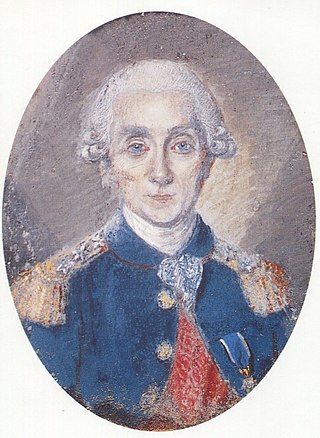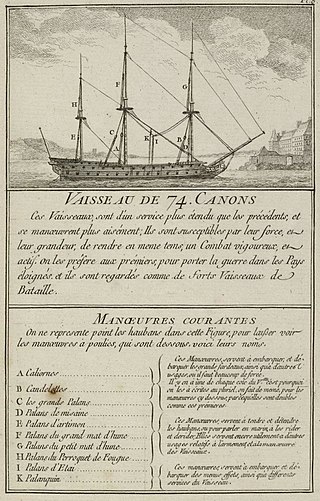
The Battle of the Saintes, also known as the Battle of Dominica, was an important naval battle in the Caribbean between the British and the French that took place 9–12 April 1782. The British victory was considered their greatest over the French during the American Revolutionary War.

The Battle of Grenada took place on 6 July 1779 during the American Revolutionary War in the West Indies between the British Royal Navy and the French Navy, just off the coast of Grenada. The British fleet of Admiral John Byron had sailed in an attempt to relieve Grenada, which the French forces of the Comte D'Estaing had just captured.

HMS Formidable was a 98-gun second rate man-of-war serving the Royal Navy.
Caton was a 64-gun ship of the line of the French Navy, launched in 1777.
Sceptre was a 74-gun ship of the line of the French Navy. Built under the Ancien Régime, she took part in the naval operations in the American Revolutionary War. At the Revolution, she took part in the main actions of the French Revolutionary Wars, notably the so-called Glorious First of June and in Bruix' expedition of 1799. Showing her age by the rise of the First French Empire, she was hulked and eventually broken up.

Neptune was a 74-gun ship of the line of the French Navy.

Hector was a 74-gun ship of the line of the French Navy, lead ship of her class. Hector was launched in 1755 and fought in the American Revolutionary War during which she captured two ships of the British Royal Navy on 14 August 1778. In 1782, the ship was captured by the Royal Navy at the Battle of the Saintes in 1782. Taken into service by the Royal Navy, the vessel was renamed HMS Hector. On 5 September 1782. HMS Hector fought two French frigates. Severely damaged during the battle, and by a hurricane that followed later in September, Hector sank on 4 October 1782.

Charles René Dominique Sochet, Chevalier Destouches, also often spelled Des Touches, was a Chef d'Escadre in the French Navy. He is most widely known for his participation in the War of American Independence, where he saw action in the Battle of Cape Henry in 1781 and in the Battle of the Saintes in 1782.
The Citoyen was a 74-gun ship of the line of the French Navy, lead ship of her class to a design by Joseph-Louis Ollivier. She was funded by a don des vaisseaux donation from the Bankers and General Treasurers of the Army.

Palmier was a 74-gun ship of the line of the French Navy.

Intrépide was a 74-gun ship of the line of the French Navy. She was of three ships of the Monarque class, all launched in 1747, the others being Monarque and Sceptre.
Sagittaire was a 50-gun ship of the line of the French Navy.

Antoine Cresp de Saint-Césaire was a French Navy officer. He served in the War of American Independence.
Armand Le Gardeur de Tilly was a French Navy officer. He served in the War of American Independence.

Joseph-Bernard de Chabert-Cogolin was a French Navy officer. He served in the War of American Independence.
Bon Chrétien de Briqueville was a French Navy officer. He served in the War of American Independence, earning membership in the Society of the Cincinnati, and was one of the prominent figures of the Académie de Marine.

Pierre René Marie de Vaugiraud de Rosnay was a French Navy officer. He served in the War of American Independence, earning membership in the Society of the Cincinnati. He was later a virulent Royalist and counter-Revolutionary.
François-Aymar de Monteil was a French Navy officer. He served in the War of American Independence, earning membership in the Society of the Cincinnati. He was also a member and director of the Académie de Marine.
Zodiaque was a 74-gun Diadème-class ship of the line of the French Navy.

Armand-Claude Poute de Nieuil was a French Navy officer. He served during the War of American Independence.













